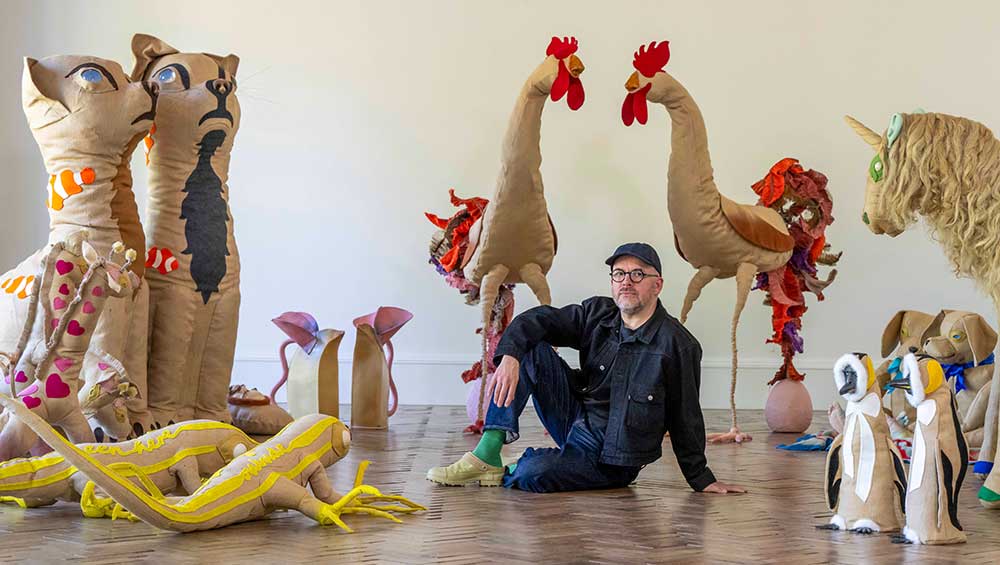
Jonathan Baldock: WYRD, Jupiter Artland. Photo:Neil Hanna.
by VERONICA SIMPSON
You expect cheeky with Jonathan Baldock (b1980, Kent). My first up close encounter with his work was at the Hayward Gallery’s 2022 group show Strange Clay: Ceramics in Contemporary Art, where his multi-limbed ceramic totems were accompanied by a soundtrack of burps, fizzings and farts. Then came an even more joyous eruption of textiles and ceramics, in his Touch Wood site-specific show at Yorkshire Sculpture Park in 2023, where one of the most memorable pieces was a large and colourfully appliqued medieval man, bent over, his buttocks bare, peeking between his legs. It was inspired by 15th-century carvings Baldock had found while researching in Wakefield Cathedral, tucked out of sight in the misericords (ledges under folding seats on which the occupant can rest while standing) in the choristers’ area. He says he loved the idea of those medieval wood carvers, hard at work for their cathedral overlords, having a delicious moment of rebellion, of doing something for themselves.
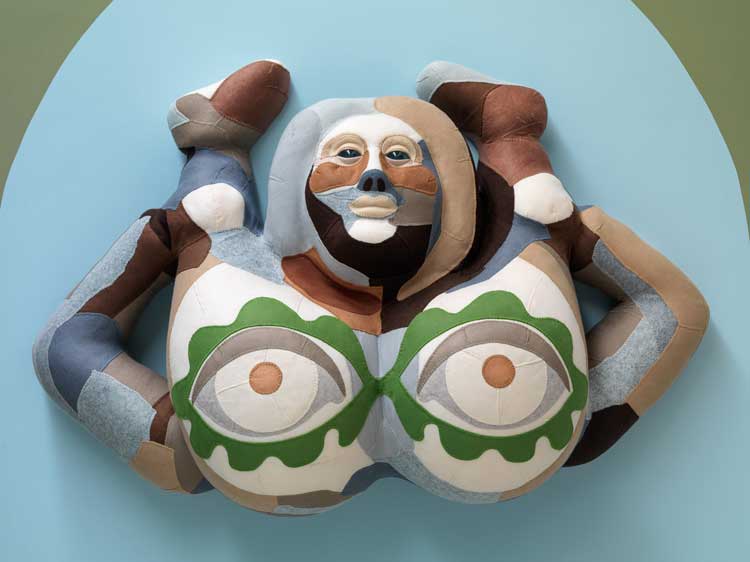
Jonathan Baldock, Be fruitful and multiply, 2023. Polystyrene, felt, cotton thread, wood and glass, 143 x 213 x 74cm (56 1/4 x 83 7/8 x 29 1/8in). Copyright Jonathan Baldock. Courtesy the artist and Stephen Friedman Gallery, London and New York. Photo: Mark Reeves.
Reclaiming space for the overlooked and under-represented, unpicking the straitjacket of normative narratives with humour, sensuality and insight, is key to Baldock’s art. He broke away from conventions early: a talented, working-class boy from Kent, he had a gift for painting, which carried him through a BA in fine art painting at Winchester School of Art (2000-03) and then an MA at the Royal College of Art (2003-05). But after that time of intense scholarship, what ultimately drew him away from oils was the lure of textiles and the crafts that he had learned from his mother, and his grandmother – whom he describes at the opening of his new Jupiter Artland commission as, “always having some crochet on the go while watching EastEnders”.
Textiles, clay and basketry, the simple folk practices and traditions of his forbears, of all working men and women, have become the media for this versatile artist, something through which to express his gift for narrative, and his outsider status – both as a gay man, growing up in the 1980s and 90s when that wasn’t an “acceptable” identity, and as a working-class man in an art world powered by elitism and feverish financial speculation. Revelling in the “naughtiness” of making fine art in materials which, until recently, were not considered “appropriate”, he has infused his poetic creations with his own personal pick and mix of mythologies, ancient and modern, from pagan characters to queer graffiti. And the gloriously outsized and unapologetically non-binary fabric animals that currently fill Jupiter Artland’s ornate Jacobean ballroom, in his show entitled WYRD, bring a delicious new strand to his work.
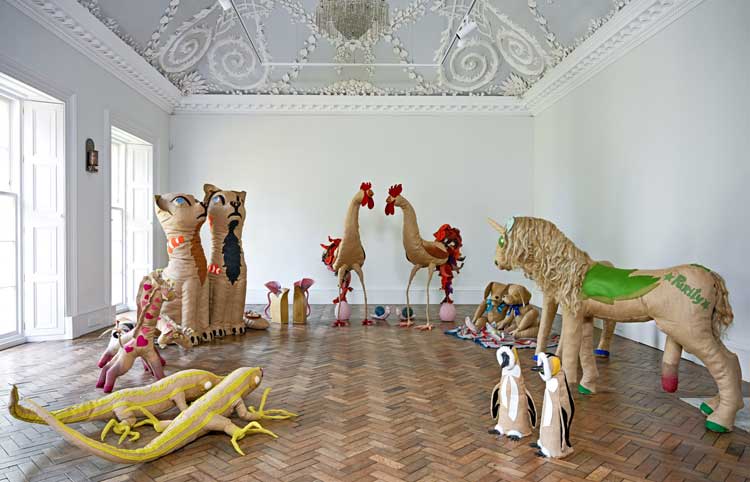
Jonathan Baldock: WYRD, installation view, Jupiter Artland, 2025. Photo: Neil Hanna.
But while there is cheekiness, there is also poignancy and profundity – an awareness of the ephemerality of our myths, old and new, and those who create them; and the gift of infusing his works with ideas everyone can relate to. Where the Yorkshire Sculpture Park show allowed him to create, as I stated in my review for Studio International at the time, “a temple to rural and pagan typologies, part sanctuary, part reliquary”, Jupiter Artland’s commission is a Noah’s ark of non-binary stuffed toys, beautifully stitched, adorned with applique motifs and ceramic body parts. Most of us will have had an animal – if not several – resembling one of these, to which we were wedded as children. Displayed in the manor house’s ballroom, the pomp and ceremony contrast with their lovable, tactile, everydayness, while their otherworldy, at times grotesque, qualities provoke a questioning of how societal or scientific systems or ideas, once “normal”-ised, can become cruel and othering.
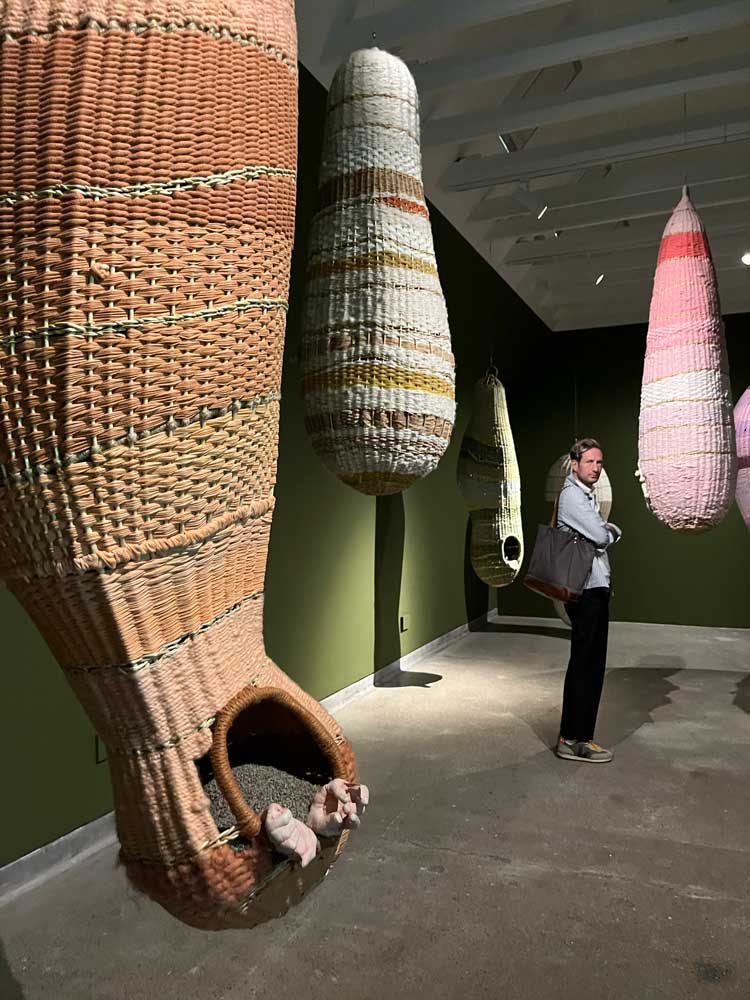
Jonathan Baldock: Warm Inside, installation view, Lower Steadings, 2025. Photo: Veronica Simpson.
In a nearby converted barn, the Lower Steadings, we see a different expression of Baldock’s art, with the installation Warm Inside, first commissioned by Accelerator, Stockholm, in 2021. Hand-crafted hanging baskets, partially enclosed in soft wool pelts, dangle from the ceiling like pupae or wombs, with ceramic hands, feet or partial faces visible through their apertures. They “house and protect bodies on the brink of transformation”, states the wall caption.
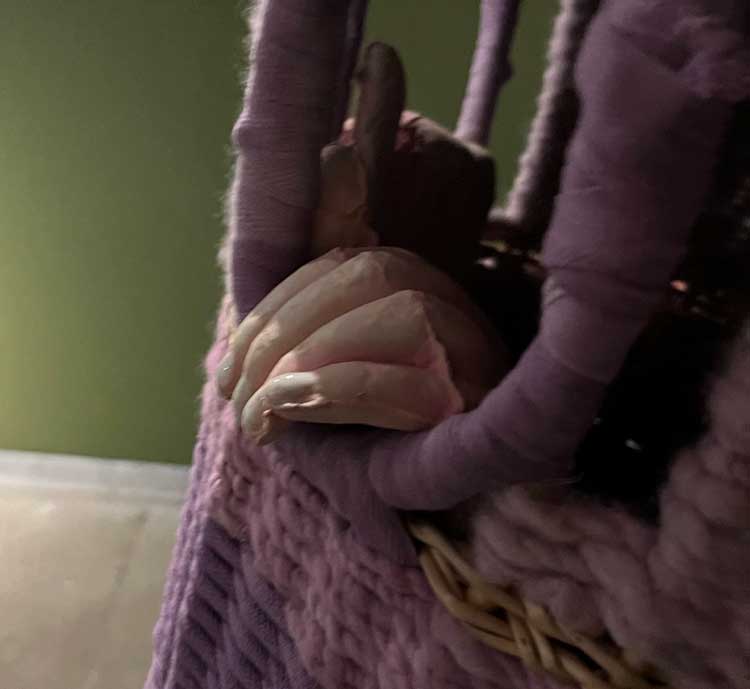
Jonathan Baldock: WYRD, installation view, Jupiter Artland, 2025. Photo: Veronica Simpson.
Baldock’s rich imaginative and material world has been celebrated with multiple solo shows since his 2019 show Facecrime, at Camden Arts Centre in London, revealed the abundant fruits of a Freelands Lomax Ceramics fellowship, travelling to Tramway in Glasgow later that year and to Bluecoat, Liverpool in 2020. He has two studios in east London, one for clay and the other for textiles, and is represented by Stephen Friedman Gallery, London, and Nicelle Beauchene, New York.
Studio International spoke with the artist in person at the opening of his show at Jupiter Artland, Edinburgh.
Veronica Simpson: Nicky [Wilson, who co-owns Jupiter Artland with her husband, Robert] says this show started with the penguins at Edinburgh Zoo. Can you explain?
Jonathan Baldock: It was noted that there were gay penguins in the community at Edinburgh zoo. And it’s funny how it was covered in the media. The suggestion was that they were gay because there weren’t any female penguins in the enclosure, as if that made them “innocent”. There’s been a lot of coverage about gayness in penguins, and many other animals. There are more than 1,500 species in which queerness has been recorded over the last 100 years. I grew up with quite a religious background, with a belief in “the natural order” - that male and female go together, as part of an ideal of evolution. And with this work, all the animals have been studied as having areas of queerness.
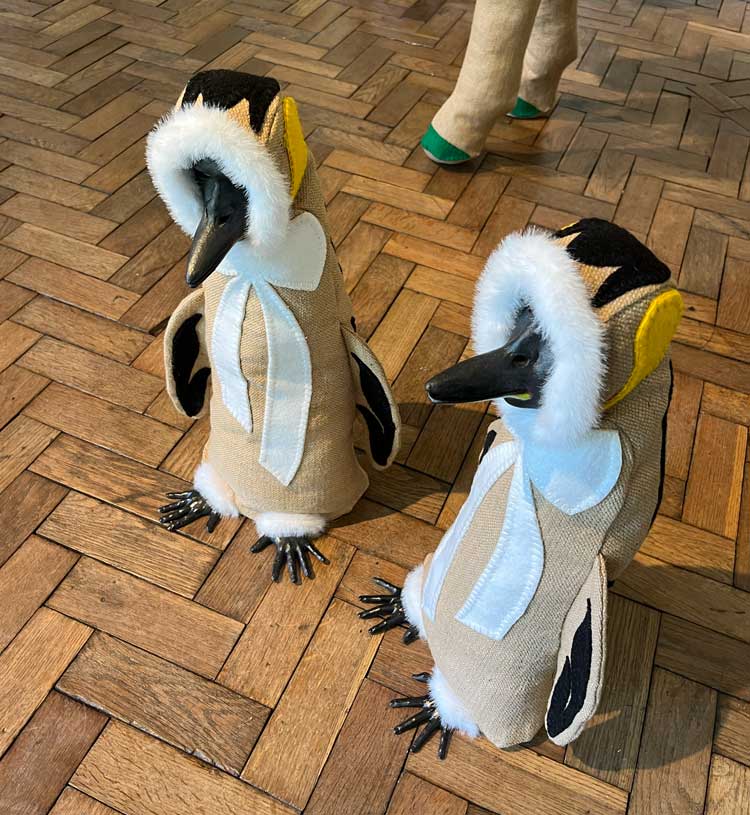
Jonathan Baldock: WYRD, installation view, Jupiter Artland, 2025. Photo: Veronica Simpson.
The title of the show, WYRD, was originally a Norse word. And in that old English usage, it doesn’t mean strange or odd. Back then, it was associated with magical powers. And I love that. Weird is a word that’s often used to describe me. I like the use of that word, I’m reclaiming it and giving it power. This is a weird cast of animals that take on a mythical element. We have the unicorn, the double-headed giraffe. And I think from a queer perspective, we identify with the “monsters”, the creatures that are outside the rules of society. They’re law breakers, rule breakers if you will. I’ve imbued these animals with powers. They might have the features of myself and of my partner (one unicorn has my ears, the other his ears). And there’s a nod to Noah’s ark as they’re arranged two by two. They are gathering together. I guess it’s a little bit of a space of interspecies love and gathering and community.
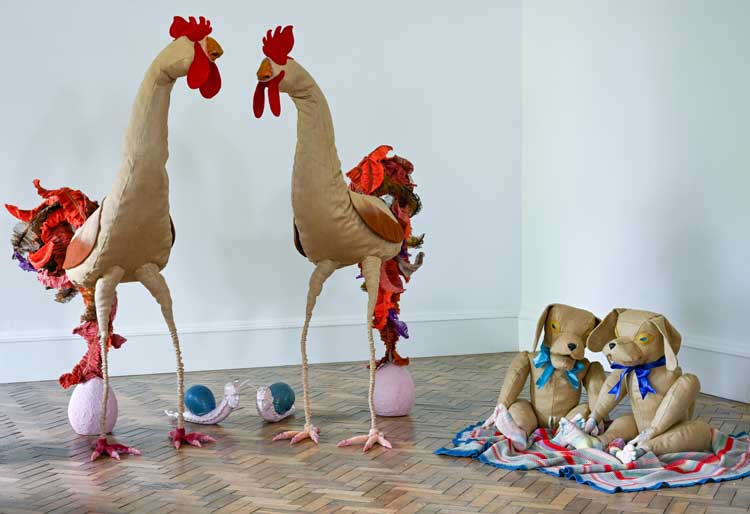
Jonathan Baldock: WYRD, installation view, Jupiter Artland, 2025. Photo: Neil Hanna.
I’m very interested in our relationships with the natural world. I’ve found faith in nature and the natural world. I’ve looked to it for sustenance, spiritual sustenance. I wanted the show to be personal but it’s also joyful, full of love. I make all the work – it’s just me and my assistant. All made by hand. This is where the traces of body are evident, not just in the casts in the work – the ceramic elements – but the physical experience. I have played with scale, things that should be small are big, and vice versa. I’ve made them by manipulating patterns I’ve found in 1970s and 80s “how to make a toy” books. They have a twee quality, but it’s that connection to childhood and freedom and a wildness that I’m celebrating.
I did a lot of reading for this show, including Joan Roughgarden’s Evolution’s Rainbow, Sacha Coward’s Queer as Folklore, Jack Halberstam’s Wild Things, and there are connections, too, to Maurice Sendak’s Where the Wild Things Are.
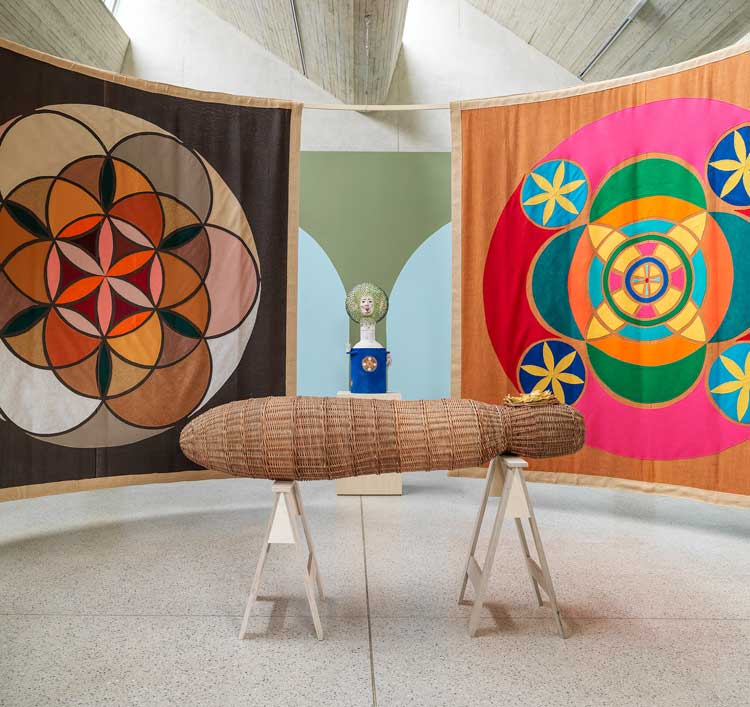
Jonathan Baldock, They tried to bury me, They didn't realise I was a seed, 2023. Installation view, Yorkshire Sculpture Park. Courtesy the artist; Stephen Friedman Gallery, London and New York and Yorkshire Sculpture Park. Photo: © Mark Reeves.
VS: I loved your show at Yorkshire Sculpture Park (YSP), which is one of my favourite site-specific or responsive shows ever, with the way it animated that beautiful, daylit, rammed-earth building and the revelation of those Wakefield Cathedral misericord carvings.
JB: They kind of blew my mind. I got really obsessed with them. There were tours going on all the time, but the guides would never point them out.
VS: How did you discover them?
JB: I found them on a blog. Because, usually, when I do a show, I like to find out what hidden treasures there are in that area. They were right up my street. The whole process of trying to find them was a challenge because you want to find the naughty ones, not the Victorian ones. But the medieval ones are just fantastic.
VS: With your celebratory parade of non-binary animals at Jupiter, you are suggesting that it was the Darwinian obsession with classification and finding order in nature that has driven so much of our prevailing narrative. It is great to be able to question – or query – it.
JB: Query, yes (laughs). And for me there’s something special about presenting that narrative here. Nicky and Robert [Jupiter Artland’s owners] are real characters and amazing, but as a visitor there’s a gentility about this place. I said: “I hope you don’t mind, I’m going to put big cocks on the unicorns.” And Nicky said: “Yes, go for it.” She totally understood why that needed to be there too.
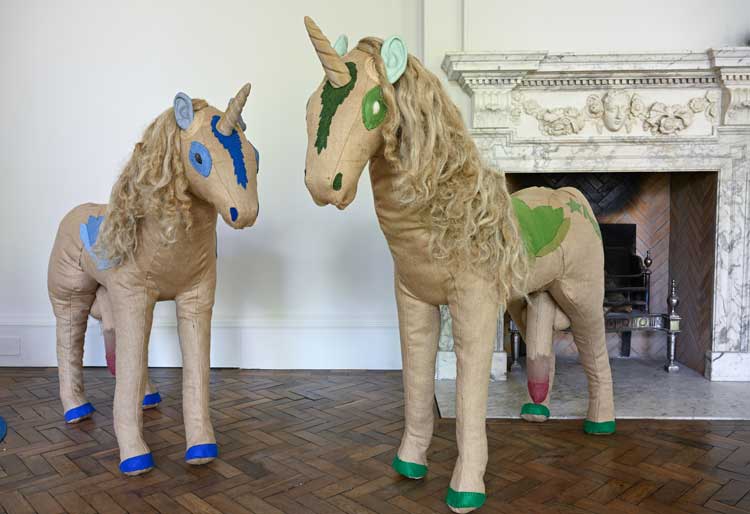
Jonathan Baldock: WYRD, installation view, Jupiter Artland, 2025. Photo: Neil Hanna.
VS: But why unicorns? Are you suggesting they existed?
JB: Well for gays, they exist, absolutely (laughter). You’ll see a lot of unicorns at Pride. Also, there is something very sexual about them – about the horn, being very phallic. These two unicorns have a little tramp stamp on their bottoms, and they’ve got luscious manes. I thought, out of all of them, they would be the saucy ones. They were the ones I imagined in silver micro shorts.
VS: When I spoke to the YSP curator, Sarah Coulson, she said you were fascinated by gargoyles. And I thought, yes, gargoyles are transgressive symbols, they are so loaded. That sense of ugliness and what that says about us. There’s nothing in that Jupiter ballroom that’s ugly, but there is a hint of the grotesque.
JB: Oh, I hope so! One of the things for me as a maker, I look at the gargoyles and I look at the people making them, I imagine them working really hard. It was pretty awful conditions for them, so the amount of fun and respite they would have had being able to make those. I’m always drawn to the grotesque.
VS: And in the history of art, there is plenty of grotesque: look at Bruegel, look at Goya, at Hogarth.
JB: Of course! And making the work accessible to everybody is really important to me, because I don’t come from an artistic background, just a normal working-person’s background. We didn’t go to art galleries and museums. But you can engage with people, if you use certain materials, with humility. That can be very powerful.
People love touching my work. I don’t mind it at all. With sculpture, it’s an important part of engaging with the work. The benefit I have of using these materials is that people have a sense of what it is to touch that texture.
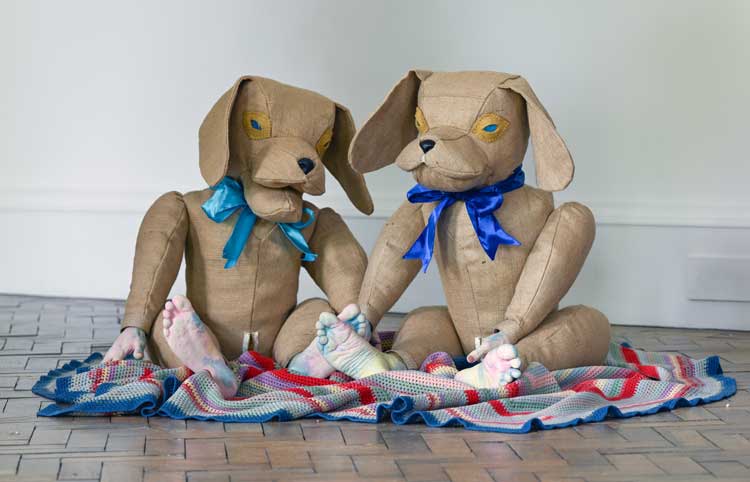
Jonathan Baldock: WYRD, installation view, Jupiter Artland, 2025. Photo: Neil Hanna.
VS: Yet you studied fine art painting. When did you pivot to working with materials with which everyone can engage?
JB: I started doing these things (with textiles) while I was at art school, because I could do them in my flat. I couldn’t afford a studio. I’d do it really on the cheap. What I realise now is that the hardest thing is the cost of making something yourself. In many ways, it would be cheaper to get something fabricated and I’d just collect the fee. Just supporting myself and my assistant, it’s tough, I’m not going to lie. I’m not doing things that are commercial.
VS: But we have made so much headway in the last few years in bringing textiles and ceramics out of that craft silo and into the art sphere.
JB: It’s still looked at with a lot of suspicion. But I think we have made a huge amount of progress.
VS: Audiences seem to love it.
JB: Yes, but I don’t think they’re the ones calling the shots. I think collectors want things in bronze, and paintings. With textiles, people are sniffy: is it going to last? It’s never going to make that kind of money. But as public funding gets more squeezed, there is a move towards that American approach of looking for patronage, which has come back in a big way, in a very conservative way. I come from painting. I did painting at the Royal College of Art. In my year, there was Anthea Hamilton and Monster Chetwynd. There were people in the painting department who weren’t painting - they were using the language of painting in a broad, exciting, expansive way. I went back there a month ago to do a lecture and now there are 150 people in the year, it’s all done in one year. It was free when I went there. [Fees now start at £17,000 for UK students and go up to £39,750 for international students for a one-year painting MA, according to the RCA website.] The work I saw this year was all painting and mostly figurative. I thought: how has this happened in 20 years? Even going to do an art degree, if you don’t come from an art background, was a risk then and it’s even more so now. My mum was concerned about what job I was going to get. I had no idea. I was in love with my art tutors, and they were supportive. I had amazing tutors at the Royal College, including Vanessa Jackson.
VS: Are you being pushed to be more commercial?
JB: I’m really lucky that they (his gallery, Stephen Friedman) don’t push me in that way. But then there’s also the thing that you need money … And I could get completely lost in all this making and I have to support myself. It’s a little bit feast and famine. You’re paying for everyone else’s time and then there’s nothing left for you. There’s a madness to this career. But it’s also the best. I love making. I really do. It’s such a gift. And I think if you come from a normal background – I’ve seen my family have shit jobs they hate – and I love what I do. To be given a platform to do that, it’s living the dream. The only worry I have is that it might end (laughs). You only have to pick up a copy of Art Forum from 20 years ago and you think: “I remember that artist. Where are they now?” I’m not very good at not worrying about the future. I do worry.
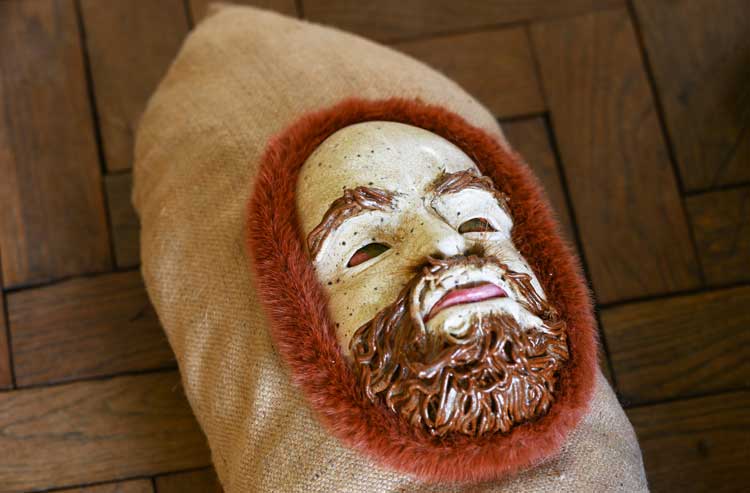
Jonathan Baldock: WYRD, installation view, Jupiter Artland, 2025. Photo: Neil Hanna.
VS: The gig economy makes life a struggle for many.
JB: Then you might get loads of things at once, and you have to say no to things. I think it’s important to talk about this, because I needed more of that insight when I was a student. I like being very transparent about it, because we do need more conversations about it. And what’s happening in art schools – it’s becoming more just for the wealthy. At the Royal College you’ve got students in head-to-toe Prada, and then someone on a scholarship who is exhausted doing weekend work, burnt out, trying to pay the rent.
VS: It’s tough, but sadly that’s the current environment. But as for your personal involvement, if it wasn’t you making the work, guiding it, thinking of those beautiful stuffed animals, they wouldn’t have the intensity, the personality and character they do.
JB: No, I don’t think they would. Again, I think that comes back to my painting background. And I know some artists pay people to do their paintings, but you know when it’s by the artist. I am very lucky I have an assistant.
VS: Do they come from a textile background? You were saying at the preview that the material you used, hemp, is very tricky to do that kind of tailoring with because it is always fraying.
JB: My current assistant was recommended by my previous assistant, and she’s from a fashion background. I’ve worked with her for the last year. She’s amazing. She’s teaching me. I think there’s a reason why so many folk stories come from textiles - with stories about weaving and needles and pricking fingers – because fabric is all about that hard, manual work, in a way that ceramic is not. Ceramic exercises something else in me, which I really enjoy. But with textiles, the work goes at its own pace. You have to follow its rules, and you have to understand the material really well. I’m a bit of a traditionalist. That (tradition and technique of making) was something I kind of missed when I was at art school. One of the things I loved was learning – doing your research – to go out and find your own language. But I do also think that if you’ve got the knowledge of how materials work, you can break those rules, and you just understand it. I think it’s power, actually. In a way, I always think of painting as a craft, a certain number of processes you have to go through. But I ended up leaning into these things I already had the knowledge of. I worked with textiles from age seven to my early teens. Then I became very aware that this was another thing that gave away my queerness and gayness, and I really tried to move away from it. I used to birdwatch and do all these things. I stepped away from them, because they were all pointers (laughs). I was odd already, but going to art school was such a great thing because you learn to accept and understand yourself. So, I started bringing those things back into my work. Textiles has always been there – even when I was doing painting, I was still making work in textiles. I was just painting as well. Painting was figuring less and less in my work.
VS: What were your themes in painting?
JB: Oh, very emotive. I was really into German expressionism, Oskar Kokoschka, Max Beckmann. I loved the really emotional painters. I would do lots of self-portraits – you know, naked with a tear coming down. Really weird. I think my mum’s kept some of them up in the attic. Then, less of that and lots of thick oils. Then there were lots of references to folk beings: I painted the Winchelsea straw man as me. It was always me and the monster. That’s been in my work for a long time. Very gestural. Really physical, I guess it was physical painting.
VS: Was it therapeutic?
JB: Yes, though you did not talk about it. It was very uncool. It was incredibly uncool to talk about your work like that. Now it’s OK.
VS: But that idea of making art as a way of working through trauma is so obvious.
JB: Of course it is. It is so obvious to think of it now. But I think that’s what drew me to art. Especially given the times then. I’m 45. The world has changed quite a lot in 25 years. When I started at art school in 2000, when the internet was not the thing it is now. I think I felt very lonely when I was growing up, and I felt I was the only one with these issues – the only gay in the world. Now, how we talk about feelings and our openness has changed completely. I remember going to art exhibitions and being touched, it was about human connection, essentially. Going back to the German expressionists, it was raw emotion I saw. I needed that. It wasn’t part of the world I existed in.
VS: I read an interview in which you said your audience is really important.
JB: It is really important. I talk about the work from a personal perspective because it’s the only way in which I feel empowered to do so, but I also think there is such significance in being in galleries, in exhibitions. To be in a physical space and experience things without a load of chatter, is to give the viewer the autonomy to decipher the work for themselves. Especially sculpture: it relies on you being in that space and having that bodily response. In a world where we have more information than ever before, but through a device that gives it to us in short bursts and it’s intense, we can disengage very easily because it’s overwhelming. Going to see exhibitions becomes even more important. We need gathering spaces as well, in a society where churches are not so important. Where else can you go where you get such a cross-section of society? The thing the internet does is help you to find your tribe, but then you don’t mix with anyone else. This is why it’s so important to have public galleries and spaces. You can go and see work and hate it or love it, but you can have that conversation around it.
• Jonathan Baldock: WYRD is at Jupiter Artland, Edinburgh, until 28 September; Warm Inside is on there until 27 July. His installation 0.1% is at the London Mithraeum Bloomberg Space until 5 July.
Click on the pictures below to enlarge